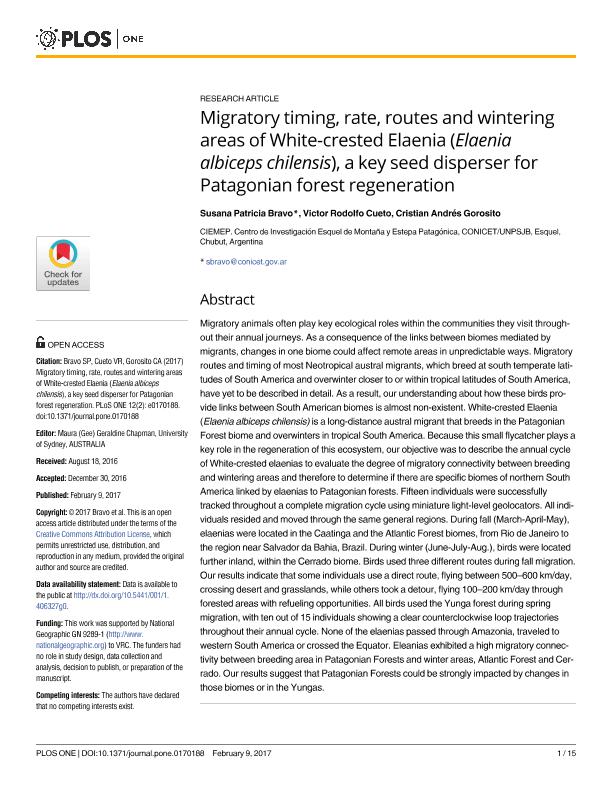Mostrar el registro sencillo del ítem
dc.contributor.author
Bravo, Susana Patricia

dc.contributor.author
Cueto, Víctor

dc.contributor.author
Gorosito, Cristian Andrés

dc.date.available
2018-08-23T15:55:09Z
dc.date.issued
2017-02
dc.identifier.citation
Bravo, Susana Patricia; Cueto, Víctor; Gorosito, Cristian Andrés; Migratory timing, rate, routes and wintering areas of White-crested Elaenia (Elaenia albiceps chilensis), a key seed disperser for Patagonian Forest regeneration; Public Library of Science; Plos One; 12; 2; 2-2017
dc.identifier.issn
1932-6203
dc.identifier.uri
http://hdl.handle.net/11336/56811
dc.description.abstract
Migratory animals often play key ecological roles within the communities they visit throughout their annual journeys. As a consequence of the links between biomes mediated by migrants, changes in one biome could affect remote areas in unpredictable ways. Migratory routes and timing of most Neotropical austral migrants, which breed at south temperate latitudes of South America and overwinter closer to or within tropical latitudes of South America, have yet to be described in detail. As a result, our understanding about how these birds provide links between South American biomes is almost non-existent. White-crested Elaenia (Elaenia albiceps chilensis) is a long-distance austral migrant that breeds in the Patagonian Forest biome and overwinters in tropical South America. Because this small flycatcher plays a key role in the regeneration of this ecosystem, our objective was to describe the annual cycle of White-crested elaenias to evaluate the degree of migratory connectivity between breeding and wintering areas and therefore to determine if there are specific biomes of northern South America linked by elaenias to Patagonian forests. Fifteen individuals were successfully tracked throughout a complete migration cycle using miniature light-level geolocators. All individuals resided and moved through the same general regions. During fall (March-April-May), elaenias were located in the Caatinga and the Atlantic Forest biomes, from Rio de Janeiro to the region near Salvador da Bahia, Brazil. During winter (June-July-Aug.), birds were located further inland, within the Cerrado biome. Birds used three different routes during fall migration. Our results indicate that some individuals use a direct route, flying between 500-600 km/day, crossing desert and grasslands, while others took a detour, flying 100-200 km/day through forested areas with refueling opportunities. All birds used the Yunga forest during spring migration, with ten out of 15 individuals showing a clear counterclockwise loop trajectories throughout their annual cycle. None of the elaenias passed through Amazonia, traveled to western South America or crossed the Equator. Eleanias exhibited a high migratory connectivity between breeding area in Patagonian Forests and winter areas, Atlantic Forest and Cerrado. Our results suggest that Patagonian Forests could be strongly impacted by changes in those biomes or in the Yungas.
dc.format
application/pdf
dc.language.iso
eng
dc.publisher
Public Library of Science

dc.rights
info:eu-repo/semantics/openAccess
dc.rights.uri
https://creativecommons.org/licenses/by-nc-sa/2.5/ar/
dc.subject
Bird Migration
dc.subject
South America
dc.subject
Small Light-Level Geolocators
dc.subject
Loop Migration
dc.subject.classification
Otras Ciencias Biológicas

dc.subject.classification
Ciencias Biológicas

dc.subject.classification
CIENCIAS NATURALES Y EXACTAS

dc.title
Migratory timing, rate, routes and wintering areas of White-crested Elaenia (Elaenia albiceps chilensis), a key seed disperser for Patagonian Forest regeneration
dc.type
info:eu-repo/semantics/article
dc.type
info:ar-repo/semantics/artículo
dc.type
info:eu-repo/semantics/publishedVersion
dc.date.updated
2018-08-21T12:55:37Z
dc.journal.volume
12
dc.journal.number
2
dc.journal.pais
Estados Unidos

dc.journal.ciudad
San Francisco
dc.description.fil
Fil: Bravo, Susana Patricia. Consejo Nacional de Investigaciones Científicas y Técnicas. Centro Científico Tecnológico Conicet - Patagonia Norte. Centro de Investigación Esquel de Montaña y Estepa Patagóica. Universidad Nacional de la Patagonia "San Juan Bosco". Facultad de Ciencias Naturales - Sede Esquel. Centro de Investigación Esquel de Montaña y Estepa Patagónica; Argentina
dc.description.fil
Fil: Cueto, Víctor. Consejo Nacional de Investigaciones Científicas y Técnicas. Centro Científico Tecnológico Conicet - Patagonia Norte. Centro de Investigación Esquel de Montaña y Estepa Patagóica. Universidad Nacional de la Patagonia "San Juan Bosco". Facultad de Ciencias Naturales - Sede Esquel. Centro de Investigación Esquel de Montaña y Estepa Patagónica; Argentina
dc.description.fil
Fil: Gorosito, Cristian Andrés. Consejo Nacional de Investigaciones Científicas y Técnicas. Centro Científico Tecnológico Conicet - Patagonia Norte. Centro de Investigación Esquel de Montaña y Estepa Patagóica. Universidad Nacional de la Patagonia "San Juan Bosco". Facultad de Ciencias Naturales - Sede Esquel. Centro de Investigación Esquel de Montaña y Estepa Patagónica; Argentina
dc.journal.title
Plos One

dc.relation.alternativeid
info:eu-repo/semantics/altIdentifier/doi/https://dx.doi.org/10.1371/journal.pone.0170188
dc.relation.alternativeid
info:eu-repo/semantics/altIdentifier/url/http://journals.plos.org/plosone/article?id=10.1371/journal.pone.0170188
Archivos asociados
